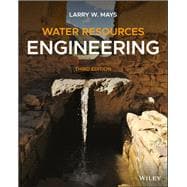Modern water conveyance and storage techniques are the product of thousands of years of human innovation; today we rely on that same innovation to devise solutions to problems surrounding the rational use and conservation of water resources, with the same overarching goal: to supply humankind with adequate, clean, freshwater. Water Resources Engineering presents an in-depth introduction to hydrological and hydraulic processes, with rigorous coverage of both core principles and practical applications.
The discussion focuses on the engineering aspects of water supply and water excess management, relating water use and the hydrological cycle to fundamental concepts of fluid mechanics, energy, and other physical concepts, while emphasizing the use of up-to-date analytical tools and methods. Now in its Third Edition, this straightforward text includes new links to additional resources that help students develop a deeper, more intuitive grasp of the material, while the depth and breadth of coverage retains a level of rigor suitable for use as a reference among practicing engineers.








